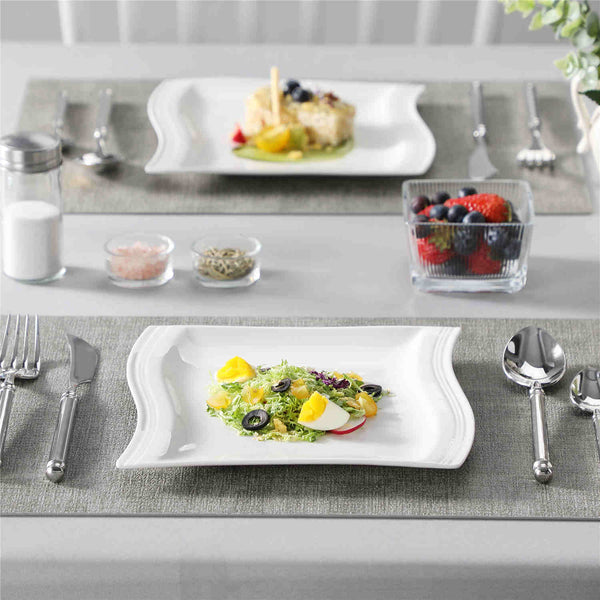How to Safely Freeze Your Meals with the Right Dinnerware Care
Navigation
- What Is A Thermal Shock?
- Step-by-Step Guide to Freezing Dinnerware Safely
- Tips For Avoiding Cracks and Breaks
- Proper Dinnerware Handling
- Conclusion
The improper way of freezing meals can spoil the original flavor of your food, and it can harm your dinnerware, too. The careless meal freezing may crack or break your dinnerware. It is necessary to understand which type of dinnerware material is suitable for properly freezing meals.
In the following guide, we will get detailed information about how to freeze meals in the right dinnerware without affecting the taste and quality of meals and saving your beautiful dinnerware from damage. We will give you information about thermal shock and its effects on your dinnerware when freezing meals. You will get helpful tips on how to perform the freezing task flawlessly. Moreover, this comprehensive guide will instruct you about defrosting and reheating meals properly.
What Is A Thermal Shock?
Thermal shock refers to the sudden change in the temperature. The thermal shock can chip, break, or crack the pot. You must ensure that it is not too hot before placing a dinnerware piece in the freezer. The pot straight from the oven to the freezer can be subjected to a severe thermal shock. The pot must be cooled down to room temperature before putting it in the freezer.
The logic behind the damage by the thermal shock is that the molecules of a dinnerware set expand or contract speedily due to the sudden change in the temperature. The speedy movement of molecules produces an intense stress that may crack, chip, or break the dinnerware set. Thermal shock is harmful enough to make your beautiful dinnerware set unusable.
The intensity of a thermal shock varies according to the material of a dinnerware set. For example, ceramics and glass do not conduct heat speedily. The low thermal conductivity of these materials makes them more prone to damage through thermal shock. Further, different dinnerware materials have various levels of expansion and contraction when exposed to a thermal shock. Most dinnerware materials have low heat conductivity. The sudden change in the temperature affects the outer layer of the dinnerware set more quickly than the inner layer. This is the reason why you find most thermal shock damage on the rims of dishes, bowls, and plates.
Managing Temperature Transitions
It is necessary to learn how to manage temperature transitions when you intend to freeze meals. The basic rule is never to put a dish in the freezer straight from the oven. You need to give ample time for a meal to cool down to room temperature before placing it in the freezer. The same rule works for defrosting and reheating meals. You must allow the frozen meal some time to adjust to room temperature. It would harm the dinnerware set to put a dish directly from the freezer to the oven.
Cooling Before Freezing
The cooling before freezing can keep you safe from the frustration of the breakage of your favorite dinnerware set. The unwanted crack can be easily avoided if you perform the freezing tasks patiently. For example, if you have baked your favorite food and you want to freeze it, you first need to cool it down properly after the baking is completed. It would be good to keep it on the kitchen shelf until it comes to room temperature. Ensure that the temperature of the food inside the pot is cooled down, too. The temperature of the pot and the meal must be at room temperature before you place them in the freezer.
The instant placing of hot meals into the freezer may expose the potential damage to the food quality. The outer layer of the hot meal will be frosted quickly, while the inner layer will suffer longer at the high temperature. The phenomena can make your meal unhealthy, and it will have adverse effects on the taste of the food, too.
Step-by-Step Guide to Freezing Dinnerware Safely
Here is the step-by-step guide to freeze dinnerware safely. You can avoid any potential damage if you follow all the instructions carefully:
Allow Dishes to Cool Naturally
The most important rule for a safe dinnerware freezing is to cool it naturally. Once you have completed your baking, you must place the hot dish at room temperature. You can place it on your kitchen shelf or on some heat-resistant surface to let it cool down. The gradual cooling of the hot dish will ensure a flawless dinnerware freezing. The instant placing of hot dishes into the freezer can expose the dinnerware to a severe thermal shock.
Allow Dishes to Come to Room Temperature Patiently
You must allow hot dishes to come to room temperature patiently. You must not rush into putting hot dishes into the freezer. The thermal shock can damage your dinnerware set if you place sizzling meals in the freezer. The dinnerware set will take time to get cool. You must ensure that the dish with the meal has come to room temperature before freezing them. Different dinnerware materials take different times to cool down. You must keep in mind the material of your dinnerware when leaving it on your kitchen shelf or tabletop for cooling down.
Allow The Food Inside the Dish to Cool Down Properly
The food in the dish must be cooled down to room temperature. Sometimes, you touch the dish and feel that it is cool enough to place into the freezer. However, you would not notice that the inner layer of the food is still too hot to place into the freezer. You must check the food temperature carefully before you place it into the freezer. The hot meal in a cool dish is not safe for freezing. You may spoil its flavor and nutrients due to the quick and careless freezing.
Tips For Avoiding Cracks and Breaks
Here are some useful tips for avoiding cracks and breaks during the freezing process to make your beautiful dinnerware stay with you longer:
Avoid Placing Hot Dinnerware on Cold Surfaces
The sudden change in the temperature is the main culprit in cracking or breaking your wonderful dinnerware set. You must be careful when placing the dishes on the kitchen countertop after finishing the baking. There must be a heat-resistant mat on the shelf or the tabletop to avoid thermal shock. The cold kitchen shelf or tabletop can expose the hot dishes to thermal shock.
Avoid Exposing Dinnerware to Cold Water
Some people think it worth applying a tip that you can place hot dishes into the cold water to let them cool down quickly. This is the wrong perception. The cold water will act as a cold surface for the hot dishes, and it can be a cause of severe thermal shock. You need to let the hot dishes cool down gradually before putting them into the cold water.
Use Freezer-Safe Containers
The usage of freezer-safe containers can make your freezing tasks easier and safer. The specially designed containers for freezing purposes ensure good quality frozen food and dinnerware.
Proper Dinnerware Handling
You must be patient in handling the dinnerware set in the process of defrosting and reheating. The frozen dish is prone to crack or breakage if you put it harshly on a surface. You need to take out frosted dishes carefully and gently. The frozen dishes get hard and can easily be broken if knocked down. The frosted dishes must not be put into the oven immediately after being taken out of the freezer. You need to allow the frozen dishes to gradually reach room temperature before exposing them to the high temperature.
Conclusion
To conclude, you must be patient during the process of freezing, defrosting, and reheating of meals and dinnerware. Careless exposure to sudden temperature changes can result in damage to dinnerware and food quality. The proper handling of the dinnerware set during the freezing makes you enjoy your splendid dinnerware set longer, and it ensures good quality frozen food, too.











Leave a comment